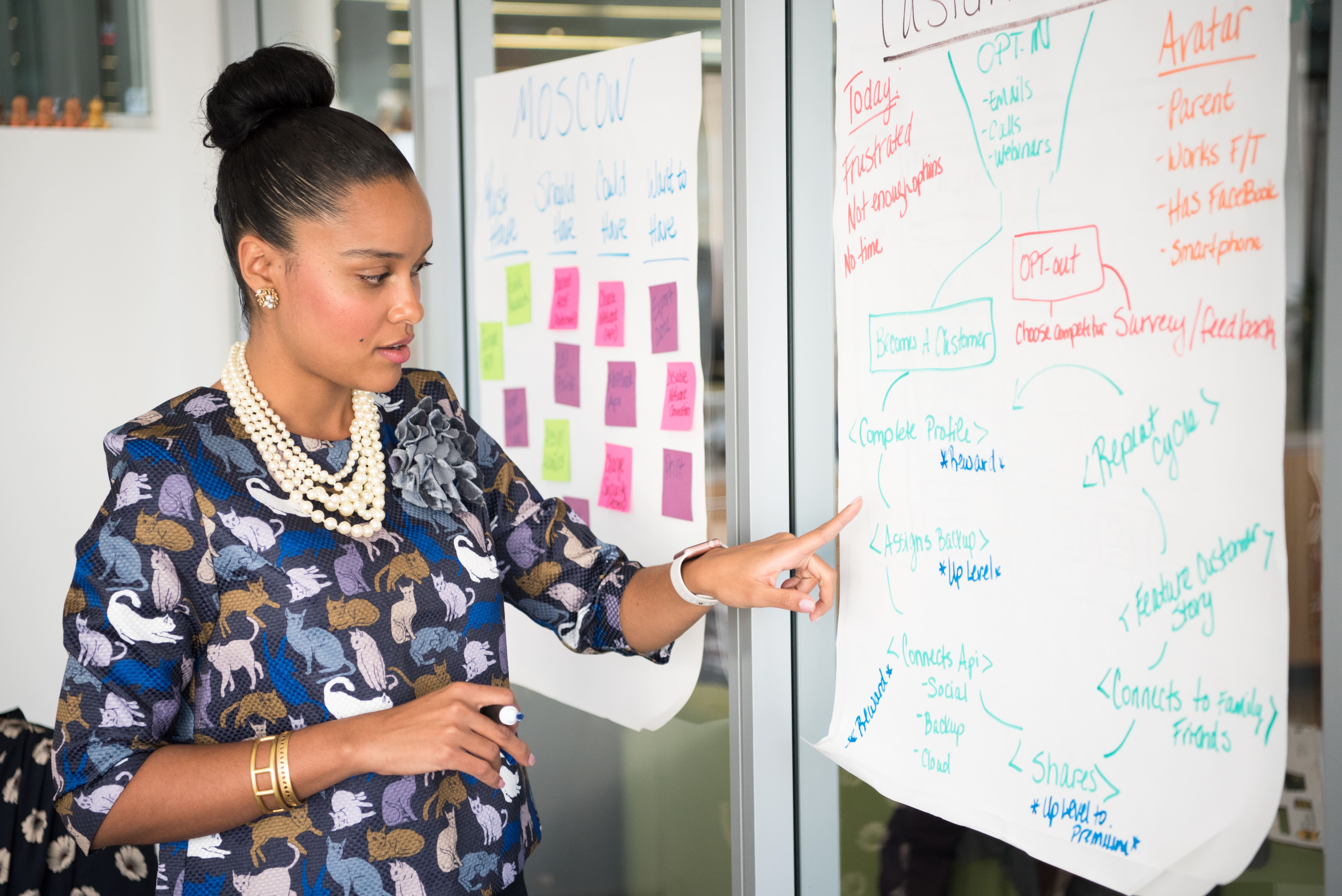The unofficial project manager
100 Days (DIYPM)
Become a better project manager within 100 days.
Drawing from real-world experience and modern principles, this collection of tips to prevent business failures and allow you to consistently deliver successful projects.

Become a better leader
Leading a project towards success requires you as the project manager to get the work done by the team members efficiently and effectively.
You need to demonstrate a clear vision, clarity in reason, practice in scheduling, and the ability to attract a talented and efficient team.
How do you show leadership? Look at these two examples:


Remember you are responsible for inspiring everyone in your team to achieve their very best.
.svg)

Keep track of the budget
This is estimating all the costs that should be required to complete the project or carry out a series of task and deliver the results.
Budget in managing projects is like the fuel to a car. First off, you will assess your financial resources and understand the sources of your funding
You need to:




Sometimes, the whole budget may seem intimidating but you will find that all you need is to iron out the plan.
.svg)

Keep monitoring your Project
Keeping a close eye on the project and ensuring all daily activities in the project are on the right track.
It requires that you get updates on the project performance and progress which now gives you clear and concise information on what is happening
This enhances internal and external accountability of the resources used and the results obtained and creates a clear understanding which then assists you in making informed decisions on the future of the project activities.
You can use simple ways of monitoring such as





.svg)

Scope Before you Start your Project
A process that helps in determining and documenting the list of all the project goals, tasks, deliverables, deadlines, and budgets as a part of the planning process.
This is the initial step in the project development process just after you have defined the project purpose and identified the project sources of funding.
It requires you to determine your business or project requirements, objectives, outcomes, and deliverables
Your dream is that the project goes on smoothly from initiation to completion, without delays or exceeding budgets. But, that rarely happens in reality. This is why scoping is important.
This is what you need to do:




.svg)

Translate different languages
This involves identifying the overall project scope and requirements, resource and skill set identification, and project plan creation and management.
Here is what you need to do when translating:





.svg)

Start building a Time-line
Timelining is creating a visual reference point that allows teams to understand the flow of steps necessary to complete a project on time. It offers an overview of all the required tasks, along with their assignments, priority levels, and milestones.
A timeline serves as a visual overview of the project, and it can be presented in a number of ways.
Come up with visual tools such as graphs, charts, and patterns showing what happens at different stages of your project.
Here are the steps to timelining





.svg)

Remain Organized
This is a function that follows after planning and it involves assigning tasks, grouping tasks into departments, assigning authority and ensuring adequate responsibility and allocation of the available resources across the project to achieve key objectives.
Here are the ways you achieve great organization in your project:






.svg)

Understand your Resources
This is the practice of allocating the resources to achieve the greatest value in a project.
The resources are the assets at your disposal which in this case would be finances, tools, people, and time. Before you start your project, you are required to assess your resources and allocate them in the most suitable and appropriate way to achieve optimal results
Types of Resources in Project Management




Remember! that all the resources mentioned above rely on time resources because it is not renewable. Time defines the costs and benefits, team productivity, project costs, and success.
.svg)

Develop a Schedule
This is the process of defining a project in detail and creating a plan for when and how it will be completed.
You will need to build a project schedule with clear deadlines for each task. This gives team members visibility into the work they’ll be expected to complete and keeps everyone involved on track.
Here are simple strategies for scheduling:




When schedule changes must be made, you ensure they are carried out and communicated according to the plan laid out at the start.
.svg)

Collaborate More Effectively
This is simply a working practice whereby individuals work together for a common purpose to achieve the project's benefit. Sharing different perspectives and skill sets long term is what fosters a collaborative environment.
It involves:





Effective collaboration can have an overwhelmingly positive impact on your team engagement, well-being, and productivity.
.svg)

Best Approach to Vetting
This involves thoroughly investigating a project you are about to undertake to make a decision to go forward with a joint project.





This involves thoroughly investigating a project you are about to undertake to make a decision to go forward with a joint project.
The main factor in vetting is costs. Be sure there is a funds allocation plan that determines how available financial resources can be best allocated among project activities and stages.
.svg)

Become more Responsible
According to Scott Berkun, the author of “Making Things Happen, A project manager is like a doctor who leads the trauma team and decides the course of action for a patient - both at the same time. Without the right kind of authority to efficiently handle all the project management issues, development teams can easily get into trouble.
Here are the main responsibility that you shoulder as the project manager in your business;








You have the responsibility of overseeing complex projects from inception to completion, shaping the project trajectory to help to reduce costs, maximize efficiencies and increase revenue.
.svg)

Set Attainable Objectives
Objectives are what you plan to achieve by the end of your project. Your project objectives should be attainable, time-bound, and specific goals you can measure at the end of your project. Objectives are more detailed and specific than project goals.
Project objectives envisions how the goal will be accomplished
Objectives are important because they convert visions into clear-cut measurable targets.
Importance of having clear objectives:





Setting objectives requires making tough choices and addressing realities. Where is your project now? What are its strengths and weaknesses? Where do you want your project to go?
.svg)

Set Measurable Milestones
A milestone is a specific point within a project's life cycle used to measure the progress toward the ultimate goal.
It allows you to see how far you’ve come and how far you still need to go in order for you to meet the ultimate goal of your project. That’s why it’s so important for you to set up these milestones and to carefully monitor them.
You need to come up with all the tasks that need to be completed. So, if you have already created your project and you’ve already laid out all of your tasks it’s time to take a closer look to decide where you can add in milestones
Here are 3 best practices in setting milestones;



.svg)

Plan to Succeed
This is the primary function of your project!
It is concerned with deciding in advance what, when, how, and who will take the necessary actions to accomplish established objectives.
The Steps to Planning are:






Your project plan describes the cost, scope, and schedule for the project. It lays out exactly what activities and tasks will be required, as well as the resources needed, from personnel to equipment to financing, and where they can be acquired.
.svg)

Promote Transparency
This involves a culture of open communication and visibility within a project team. It is all about access to information. Transparency allows stakeholders to see all angles and choices of a project that may influence or intrigue their performance.
Here are some practices to help promote transparency in your project and on your team:





.svg)

Break down the Process
The process is an activity or set of activities that accomplish a specific organizational goal. It is geared towards connecting all other project activities together and creating harmony in the project.
We can break down the process into five different phases:





.svg)

Delegate
This is the process of distributing and entrusting tasks to another team member. Sometimes, you will need to let go of some of your power in favor of another person who usually reports directly to you.
The delegated tasks must have the following key parameters:






Delegation in the workplace can be an essential tool and skill to get things done in a timely fashion. When you delegate effectively, you are able to:



.svg)

Initiate a strong foundation
This is the beginning of the project. Initiation ensures that you lay a strong foundation for a new project.
This is an important step that enables you to plan, create project schedules, and make necessary changes before the project execution. It covers setting up project infrastructure, enlisting early adopters, identifying critical success factors, and creating a project management plan.
Ask yourself these simple questions:





.svg)

Close Successfully
Closing a project is as important as other processes in Project Management. Ensuring that all deliverables are met is key to client satisfaction. It’s important that you plan for your project closure in advance. In doing so, you can ensure that your project is closed effectively.
The closure process ensures that:



The closing phase gives you the opportunity to review and evaluate the project success (or failure), which is crucial for planning and executing successful projects in the future.
.svg)

Control ensures compliance
Controlling is following a set of processes used to make it more understandable and control the quantity of time or money you spend on your projects.
The goal of controlling a project is to organize and monitor tasks to complete them on time, on budget, and meet quality standards.
Features of Project Controlling






The controlling process is the part of project management that ensures the work being done aligns with the plan. Project control plays a vital role in ensuring that projects are completed on time, within budget, and meeting all requirements.
.svg)

Build a Healthy Team
This is the process of taking a collection of individuals with different needs, backgrounds, and expertise and transforming them by various methods into an integrated, effective work unit.
In this transformation process, the goals and energies of individual contributors merge and support the objectives of the team.
Every project success starts at the team level. It is an ongoing process.
The stages of building a team are:





Team building activities can include:






.svg)

Achieve the desired Teamwork
Teamwork is working together in order to work. Teamwork is anything that improves commitment, communication, cohesion, cooperation, and celebration within the team. It ensures that the project milestones will be met within scheduled timelines and you will complete the project within the project deadline.
Here are the reasons why Teamwork is essential in a project management:











In cooperative and well-meaning teams, everybody owns their tasks perfectly and therefore, there is no real need for a micromanaging leader.
.svg)

Manage the Project Priorities
Prioritizing in Project management is the practice of focusing time and resources on work, projects, and tasks that affect high-value projects, accounts, and long-term goals.





Steven Covey suggested dividing work into four quadrants:




Managing priorities is all about clarity, importance, and urgency
.svg)

Achieve high team Morale
Which relates to your team. It is the overall outlook that employees have towards their organization or project.
It is important to look to see if anybody is experiencing burnout or is feeling disengaged with their work.
Encouraging and maintaining morale starts with the team leader. Here are the ways to boost employee morale;









When team members are happy and have good work-life balance, they're more likely to produce higher quality work. Team members who experience less stress are more focused, creative, and open to changes and new ideas.
.svg)

Break down the Structure
Structure is the visual diagram of a project, that describes what employees do, to whom they report, and how decisions are made across the project.
Organizational structures can use functions, markets, products, geographies, or processes as their guide, and cater to projects of specific sizes.
You need to consider the following when laying out a structure for your project:



Here are the types of organizational structures:









To put it simply, the structure is like a map that simply explains how your company works and how its roles are organized.
.svg)

Set and Meet Deadlines
A deadline is not just a time at which something is due but in a project, it’s a goal that’s been set, as well as an expectation that one party has of another.
In the workplace, you may have all sorts of deadlines, and depending on your project, you may have any one of the following types of deadlines:




How do you meet deadlines?:









Setting deadlines for yourself and your team means that you can plan your work effectively around the dates that the project is required, ensuring that everyone remains organized and ready for the task at hand. Without this focus, the project lacks clarity, objectives, and structure, all of which are important for effective project progression.
.svg)

Improve your Bottomline
Bottomline can be defined in a number of ways depending on your project objectives and end goal. It is the primary or most important consideration, the financial report that shows the net profit or loss or the final result.
Improving your organization's bottom line starts with answering these strategic questions:



Project managers who know their bottom line make their decisions, allocate their resources, hire their people, and structure their organization to achieve that bottom line. The bottom line is the final measure of management's effectiveness in selecting project management strategies, investing in products and services, marketing, and cost control.
.svg)

Networking for Projects
Networking is the process of connecting with other people to exchange information, develop contacts, further one’s career, and further project success.
Here are the reasons you’ll need to network for your project's success.






Networking for you as a project manager is actually about building long-term relationships as well as a good reputation over time. It involves meeting and getting to know people who you can assist, and who can potentially help you in return. Good networking has a basis of trust and support.
.svg)

Focus on scalable processes
Scaling a project means preparing for the future growth of a company. Scaling must be able to deliver more, but at the same time achieve economies of scale. This means a project increases its revenue without incurring significant costs.
You need to ask yourself if your project has the capacity to grow. Will your projects, systems, infrastructure, and team be able to accommodate growth?
Here are seven tips to consider as you scale your Projects:







.svg)

Align your project activities
Alignment is the process of aligning project activities and goals with the strategic vision of the project.
Alignment can also help improve projects' success rates and, therefore, the ability of the project to address needs and expectations.
It helps you to ensure that you invest only in those initiatives which enable you to accomplish the projects' objectives.
Here are ways of aligning your project:








.svg)

Match interests to project opportunities
The reason why most of us are in project management is to generate wealth, transform people's lives, and have a sense of accomplishment.
It is important to match your interests to project opportunities
The three major interests within any project are:

The project goals of the product. For example to sell more products, reduce the number of support calls, or strengthen brand awareness.

The interests that the developers that actually build the application have. Examples of these might be fast development, code reuse, and maintainable code.

The needs of the end users. It might be a problem they want to solve or the need for an easy way to perform a certain task.
Is your project dominated by any particular interest or is one interest totally forgotten? How do you keep the interests balanced?
.svg)

Become an Entrepreneur
Entrepreneurship is the art of starting a business to offer creative products, processes, or services and it’s full of activities. An entrepreneur takes a decision to exploit a chance and undertake the risk, being action-oriented and highly motivated to achieve specific objectives.
A business owner is an entrepreneur! As an entrepreneur must get the job done on time, within budget, and to the satisfaction of customers, so should the project manager.
Look, not every project manager is an entrepreneur, but all entrepreneurs need to be project managers! As a project manager, you need the following simple qualities of an entrepreneur:





.svg)

Own your Projects
Own it! Operate, Direct, Oversee and Manage your project!
Take responsibility for your project and its outcomes.
It means owning the decision-making process, the growth of that project, and the direction it takes.
It means a lot of very long days building something you don't know will ever make you any money. It means the freedom to choose your schedule, your partners, your employees, your location in the world, and your clients.
It means sometimes sacrificing time for hobbies, activities, friendships, and even family at times to focus on your project. It means realizing you don't know everything you thought you did and that you need to learn new things each and every day.
.svg)

Track the Metrics
Metrics are quantifiable measures that you use to track, monitor, and assess the success or failure of various project processes.
Choosing which metrics to track depends on your project's needs, objectives, and industry.
5 Key Project Metrics that you should be tracking are:





Metrics allows project managers to determine the success of a project and help them evaluate a project’s status, foresee risks, and assess team productivity and quality of work. Metrics help in measuring progress toward short and long-term goals and objectives
.svg)

Overcome the Challenges
Challenges are the reason for project failure! These are the reasons why you will not achieve your primary objectives in a project.
Project failure falls into these three primary categories namely People, Processes, and Communication.
These are the challenges that you may face in project management:









As a project and business manager you need to take care of the projects, resources, deadlines, manage the budget, ensure proper communication, foresee potential risks and what not.
.svg)

Your Project is an Investment
Projects and businesses must be understood as investments.
Then as you understand that the project is an investment you must ask yourself questions like; What will I get for my money? What will my return be? How much will I pay?
In a simple definition, an investment is an asset or item acquired with the goal of generating income or appreciation
So, considering the project as an investment, we can see that:




We can also say project management is an investment. It harmonizes an organization’s people, processes, and technology to create a replicable, resource-maximizing approach that ultimately sees more projects reach full completion. Thus it’s an investment that would bring returns.
.svg)

Be Passionate
Passion is a strong drive to change an idea or a method into a profitable venture.
Passionate project managers and business owners are more successful. If you are passionate about your project you own it.
Sometimes, when nothing else seems encouraging or inspiring, passion keeps you going because you are intensely emotional about it.
Here are reasons why passion is key to your project:










.svg)

Resolve Conflicts Effectively
This is a situation when the interests, needs, goals, or values of the project stakeholders interfere with one another.
Conflicts in project management are unavoidable. While different people bring new ideas to the table, they also get caught in disagreements, clashes, personal issues, and cultural differences.
As a project manager, you have the power to prevent conflicts from amplifying before the entire project suffers.
Conflicts arise due to:






Here are the top 10 strategies you can adopt to effectively resolve conflicts on time:









.svg)

Persist to Succeed
Persistence means giving all that you have, not more than you have and working with determination, not waiting on destiny.
Whatever the reason (or excuse), entrepreneurial persistence is the equivalent of being mentally prepared enough to do whatever it takes (within reason) to succeed.
Here are some best practices to help you tap into the power of persistence:




In Simple terms, Persistence means showing up again and again (and again) until you make it. However, it is important to know when you’ve persisted enough and it’s time for changing the approach.
.svg)

Find a Purpose
Does the project need a purpose? Yes! As a project manager, you need to find the purpose for your project.
The main purpose of a project is to offer value. It’s usually expressed in the vision and mission statements.
Choosing a more profound meaning for the project allows the project to maximize its benefits.
To build purpose into a project requires looking at the reason it exists. This reason must go deeper than just being a vehicle for making money. The project must have importance to the project and those who work on it.
Finding out the why of a project helps connect team members and the project to its innate purpose. Sometimes that's the most crucial element towards ensuring its completion.
.svg)

Adapt to Changes
Adaptation is a set of decisions or tools that relate to strategies that provide you with the tools required to navigate a variety of project challenges.
It can deliver cost savings, increased productivity, enhanced job satisfaction, and, most important of all, the ability to thrive in a rapidly changing world. But the ability to change is not sufficient. It is how you change – and how quickly you can change – that matters.
Here are several project adaptation strategies to consider:




In order to ensure adaptability is at the very heart of a project, you may have to develop a new mindset and new skills to enable the project to cope with the challenges of constant changes in the economic environment.
.svg)

Exploit Existing Resources
This involves activities such as refinement, efficiency, selection, implementation, and execution. It means you are using already existing solutions and making refinements to them to improve your project performance.
This calls for more concentration to be better at what we are already doing.
This is choosing to work and improve what you know and getting something close to what you expect instead of going for the unknown
This kind of innovation is relatively moderate, focused mainly on enhancement and efficiency — most managers of organizations feel comfortable with it. It deals with questions familiar to them: improving existing products, improving the product for a proximate market, etc.
.svg)

Explore New Alternatives
This involves looking at new territory, in terms of new technologies, markets, positions, products, services, and project models
When you explore, you are employing activities such as search, variation, risk-taking, experimentation, discovery, and innovation
This means you are choosing to look at something you aren't sure about and possibly learning more so you can improve your project performance
You are taking a step to choose an unfamiliar option with an unknown or uncertain reward value.
This type of innovation requires the project to leave its comfort zone and examine new markets, products, and project models unfamiliar to them. From the managers’ perspective, this type of innovation obliges them to venture into unfamiliar territory.
.svg)

Maintain Consistency
It's about having a clear plan and following it, then stepping back periodically to assess your results.
Being consistent allows you to establish awareness, build trust and deliver your services efficiently and profitably. Without it, your project is more likely to fail.
Consistency also helps you see your priorities clearly, which is essential when making tough decisions or setting spending limits.
Here are some key steps you can use to help yourself maintain consistency:





.svg)

Deliver Quality
This is a degree to which a set of inherent characteristics fulfill requirements of your project and thus you must define what quality means in your project.
Most project managers measure quality by the level of consumer satisfaction.
Quality separates the professional from the amateur and it takes commitment, focus, and sometimes courage, to maintain consistent project quality and deliver it within budget.
These are ways to help you maintain project quality from start to finish:










.svg)

Do Phase Review
A review is an independent view of the status and of how the project is performing against “best practice”, thus helping the project manager to identify any gaps in their own understanding
Here are the most common activities you will need to undertake during your review;






It's easy to focus only on the day-to-day running of your project, especially in the early stages. But once you're up and running, you might lose track and so is the need for a periodical review of the project performance.
A review is also useful if you have decided that your company is ready to move on to another level.
.svg)

Report at Regular Intervals
Reporting is the act of producing formal and informal reports to communicate the status of a business or project and it’s usually done at regular intervals.
It assists you in successfully managing the project and keeping it on schedule.
The reports should be documented and thus also you should:





Reports are the most valuable tool available to you and your team. Here are simplified benefits of reporting in a project:







.svg)

Assessing your project
Assessment is looking at your current situation, where you want to be, and figure out how to get there. It’s a continual cycle because projects are always growing and evolving; thus, you will meet new challenges and opportunities.
Though there are other types of assessments, all project assessments fundamentally lead to a balanced SWOT analysis of the organization. It looks at internal and external factors that are helpful or harmful to your project and how it’s run. This type of assessment is particularly interested in identifying factors in the following 4 categories:

The strongest parts of your project model and your best selling points. The core competencies of your team and your investments.

The weakest parts of your project model and weak spots in the sales funnel. What’s lacking in your team and missing from your investments?

Potential leads, investors, events, and even new target markets.

Potential competitors, reasons investors would cut funding or negative market developments.
.svg)

Successful Delivery
This refers to the comprehensive process of carrying out and completing a project.
Here are six fundamental lessons for successful project delivery:






Delivery has 4 phases.




The process of ensuring a successful delivery includes how the project will be managed, organized, and implemented till its closure.
.svg)

Solve Problems and hit your Goals
Problem solving relates to establishing processes that mitigate or remove obstacles currently preventing you from reaching your project strategic goals.
It can be described in the following steps. First of all it is necessary to determine the actual status or problem definition. The next step is the applying of the solution process. And the last step is the achievement of the wanted actual status.
Here are steps or process, you can develop your problem-solving skills and approach any issue:










Problem solving is a process, it requires your ability to adapt. You can waste a lot of resources on staying the wrong course for too long. So make a plan to reduce your risk now. Think about what you’d do if you were faced with a problem large enough to sink your project. Be as proactive as you can.
.svg)

Be aware of the Expectations
If you are a project manager or a business owner, then you are an expectations manager. Thus managing expectations is a key skill for you and for the success of your project.
Expectations are based on assumptions, beliefs and bias, and constant and effective communication is an essential tool for you to reduce the impact of such expectations on your project.
You should understand that delivering the project within schedule and on budget is certainly the goal but it's not enough to make the stakeholders, clients, teams or the community happy
Thus you must spend more effort and time on areas that matter in order to increase the chances of delivering meaningful results that are in line with your project needs and objectives.
It is important for you to ensure that everyone involved maintains realistic expectations which are feasible and intentional.
.svg)

Build and Display Respect
As a Project Manager, respect is a two-way traffic. You need to gain respect from the team members and the stakeholders involved in the project operations and also you need to respect them.
If you are working in a team, then you need to work effectively to achieve bottom-line goals and so there's a need to cultivate their respect.
Here are four elements that appear to be critical when it comes to respect:




Even the most respectful project managers may be acting disrespectfully without knowing it. Building respect is a gradual process.
You should take the time to stop and think about any of your fellow employees to determine the best use of their time and resources. Showing others this type of respect will reap mutual respect and increase success in the future.
.svg)

Show Accountability
Accountability is about the ownership of outcomes. It is your obligation to account for its activities, take responsibility for them, and be transparent about the results. You must be able to account for what happened during the project.
The concept of accountability thus consists of






The best approach to accountability is empowering the entire team to uphold the project’s accountability and thus holding each player accountable for the part they play.
.svg)

Execute your plan
This is the stage where everything you (and your team) have planned is put into action. You are now rolling up your sleeves and taking action on everything you outlined in your project.
It is usually the longest phase in a project life cycle and consumes the most energy and resources.
Here are the activities that you should embark on during execution;








No matter how well you plan, your project won’t be successful unless you can effectively implement your ideas. Successful execution then requires you to break down the project into smaller milestones, assign them to the team, start the work, collaborate, and reach the end goals of the project.
.svg)

Have a clear Vision
This is a picture that connects personal and corporate energy and values to a project.
This is an identification of the difference you will make if you accomplish your service. It demands understanding your present capabilities and values, as well as the obstacles you are going to face.
Please note that the ability to identify, articulate, and share a clear vision for the project is one of the key ingredients to a project success. At worst, lack of vision wastes time and money, and project failure.
Having a sound and great vision gives you and your team the ultimate focus and motivation that’s needed to deliver a strategic project.
Put your vision in a statement so you can provide a description or declaration of what your project wants to accomplish upon its completion.
.svg)

Setting goals for your project
A project goal is what needs to be accomplished
Goals articulate the desired outcome. Project goals are high-level and broad, often requiring a long-lens view. This is because they are the “what” of your project. Not the “how.”
Goals include three components: the desired outcome (performance), the specific end date (time frame), and the dedicated assets that will be used (resources).
Here are steps you can take when setting your project goals:





Setting goals and objectives early on in your project lifecycle can help motivate, establish key indicators of progress and act as a road map for the team.
.svg)

Develop a Business Mindset
Ordinary mindset and thinking cannot achieve extraordinary or great results; that is why we say think out of the box. It requires an open-minded approach.
Thriving in any business environment requires a project managers' mindset. This means that you have to be defining goals, plan, and execute benchmarks and milestones. Gain team building and effective communication skills.
Be in the right mindset to organize and tackle your daily tasks and get the most out of your time.
Here are some of the important mindset qualities that can lead you to succeed in your project;







.svg)

Manage your Project Life Cycle
A life cycle is the sequence of phases through which a project progresses.
Being conscious of your project life cycle steps will help you plan and organize your projects and tasks so that they go off without any hitches.
Does any project have five major stages of the project life cycle?





These stages should be meant to define the following aspects:




These phases are considered part of a sequential process or have an overlapping relationship, meaning sometimes they may be carried out independently or they may overlap for the benefit of the entire project.
.svg)

Run a Successful Project
This is defined by the level of efficiency the project achieved to reach the project objectives. So a project is considered to be successful if the goals are achieved
Here are the factors that are crucial to the success of your project














.svg)

Simplicity
Simplicity means sticking to streamlined processes that have not only been well-designed but are also regularly maintained.
By managing your project with simplicity in mind, you will ensure it does not expend any time or energy on anything but developing the project.
Simple is good. It improves communication, avoids misunderstanding, gets to the point without the waffle, and saves time.
If you want to be more productive with minimal effort and stress, learn how to simplify and stay focused. Some benefits that come with simplicity are




.svg)

Attitude
This is a tendency for you to respond positively or negatively towards your project activities.
Being a project manager means dealing with optimists, pessimists, and every attitude in between. It’s part of your role to deal with different types of individuals and reach a common ground that will enable the project to achieve its objectives.
The following are 8 attitudes towards the success of your project:








.svg)

Creativity
This is the ability to generate and apply new ideas in response to the tasks involved in the project processes
A creative approach provides new insights into problems making it easier to see what’s wrong instead of just knowing what needs fixing.
Creative project management helps develop the required skills and abilities to get through different stages of the project.
It develops an innovative thinking process, improves communication skills with people, and presents better opportunities for change while also avoiding setbacks along with other difficulties faced by project management traditional methods.
Here are some methods you can use to enhance creativity:






.svg)

Diversity
Diversity is an important factor in many business cultures and values. It is more effective when you are working with a team or a number of employees as you are able to bring on board different types of personalities and skills.
Project leaders over time have felt that team diversity increases the project value. Here are benefits and reasons why you should consider having diversity in your team;




So if you embrace diversity in your project you are going to benefit from the different experiences, strengths, and ideas of a diverse workforce which, in turn, leads to innovative solutions and a successful project.
.svg)

Inclusion
Inclusion is actively involving every employee's ideas, knowledge, perspectives, approaches, and styles to maximize your project success.
This means ensuring that all team members in a project have access to all services and positions, regardless of age, gender, origin, sexual orientation or health status.
Inclusion refers to the degree to which diverse individuals are able to:




.svg)

Roles
When we talk about roles, we are asking ourselves, “What do project managers or business owners do?”
They make the project goals their own and use their skills and expertise to inspire a sense of shared purpose within the project team.
So, as a project manager, your main roles are risk management, people management, work management, and resource management. These duties also include being in coordination with clients and stakeholders.
12 main roles of a project manager or a business owner are:












.svg)

Risk Exposure
Risk exposure is a quantitative assessment of how vulnerable the project could be to various sources of project risk.
It is the quantified potential loss from project activities currently underway or planned.
The most common types of project risks are:




.svg)

Value
Project value encompasses all elements that determine the well-being and health of a project. It involves financial assets, equity, fixtures, brand recognition and trademarks to name a few.
There are elements that make up the project value and these include those of the shareholders, clients, managerial, social and employee knowledge.
Use these factors to measure the values of your project:










.svg)

Crisis
Crisis refers to an unexpected, unplanned situation or rather threat that suddenly dawns upon a project out of nowhere. It means an event that threatens the very stability of a project.
The major types of crisis are:




Tips on how to handle crisis in project management successfully:






.svg)

Technology
This refers to electronic objects or systems that help you accomplish tasks effectively and efficiently.
Technology will always be of great help as it helps project teams manage the various functions, roles, and responsibilities assigned to them.
Here are some ways technology enhances project management:








.svg)

Skills
As a project manager, you may naturally possess project management skills and sometimes, you may learn through experience or gain them formally from training.
These are the skills that you need to be an effective project manager for your business:
You need both hard and soft skills. Hard skills are job-related competencies and abilities that are necessary to complete your work, while soft skills are personal qualities and traits that impact how you work.










.svg)

Recruitment
This is the process of finding and hiring the best and most qualified candidate for a job opening, in a timely and cost-effective manner.
There is a need to have a recruitment strategy that will help you get the best people to work in your team. It should be detailing the positions, timescales, and explain why and how it will be conducted.
Having a strong recruitment strategy increases your chances of getting the best workers while reducing the time spent on the hiring process and bringing down the costs. Your strategy must be clear, realistic, and easy to communicate.
This is what you need to know about creating a project recruitment strategy:





.svg)

Training
Training is crucial for organizational development and success. It is fruitful to both employers and employees of an organization. An employee will become more efficient and productive if he is trained well.
The benefits of training can be summed up as:





Here the method of training you can adopt in your project:
On the job training - given to the employees within the everyday working of a concern. It is a simple and cost-effective training method. The motto of such training is “learning by doing.”
Off-the-job training - training is provided away from the actual working condition. It is generally used in the case of new employees. Instances of off-the-job training methods are workshops, seminars, conferences, etc.
.svg)

Inspiration
It starts with you. You need to be inspired to inspire your team.
A motivated and inspired team is more efficient and effective: it is the key to project success
How to engage and inspire your team:






.svg)

Coordination
Coordination is the common thread that runs through all activities in your project such as – purchase, production, sales, and finance to ensure continuity.
Why do you need Coordination in your projects? Here are the aims of Coordination:









.svg)

This is the execution of your project plan.
Implementation takes time, usually more than it is planned, and many external constraints can appear, which you should consider when initiating the implementation step.
Here is what you should do before you start the implementation phase:




The objectives that you should achieve during the implementation phase can be summarized as follow:





.svg)

Integrity
Integrity is doing what you say you're going to do even when there's no one there to see you doing it. It also means owning up to your mistakes and remaining accountable.
Values which define integrity such as “authenticity,” “trustworthiness” and “transparency” are important for your project success.
Here are the most common traits of integrity that you can show in your project:






.svg)

Dependability
This is the quality that lets people know that you will do what you said you would do, when you said you will do it, and you will do it to the best of your ability – each and every time.
3 simple ways to build a dependable project:



Here are a few areas in which dependability is measured; what boxes are you checking off?





.svg)

Software
This is a set of programs/instructions which enables a user to perform a task. Software has become the soul for every organization in this digital era to maintain agility, efficiency, service and reduce errors.
Using the appropriate software in your project will open a lot of doors of opportunities. It will keep your documents, allow you to communicate, keep the data safe and secure client’s information.
Here are the benefits of using the software in your project:








.svg)

Efficiency
This is about getting the most out of your resources to achieve your project objectives. The objectives are achieved in as little (time) expenditure as possible. It is a measure of profitability.
How are the resources being best used? How much effort is actually required to complete a task? It’s all about the ‘HOW’.
Here are best practices that you can use to boost efficiency as a project manager who is managing their project:











.svg)

Change
The world is changing everyday: the population is changing, customer trends are changing, technology is changing and the economy is changing.
As a project manager, you will be required to embrace change and adapt to today's fast-moving business environment.
Change in a project leads to many positive aspects – that leads to retaining a competitive edge and also remaining relevant in your business area. Change encourages innovation, develops skills, develops staff and leads to better project opportunities, and improves team’s morale
Here are simple measures to ensure that you are compatible with change and adapt easily to it:






.svg)

Assertive
Are you assertive enough to succeed in your projects?
This describes how you defend your interest as a project manager. Assertive communication is a key to better project management and project delivery
Assertiveness in your projects ensures that everyone gets a favorable outcome when discussing their expectations of both themselves and others.
Delivering a satisfactory result depends upon you being willing to stand up for your own best interests and those of the projects in delivering the best possible work.
Here are some traits that you should exhibit to show an assertive tone and mindset;








.svg)

Participation
Participation is ensuring every player in the project takes part in achieving the objectives. Participation is the key to team results.
If you want to achieve optimum team participation, you need to let your team members know what you expect, and what is expected from them.
As a project manager, you are the team leader, your job is to lead and manage, and to get the team to function as a cohesive unit. To meet this goal, you will be required to lead by example.
The most effective techniques to encourage team members to participate in the project are:




.svg)

Motivation
This is all about the factors that encourage you and your team to be continually committed and interested in achieving the project goals.
Here are strategies to help you and your team keep motivated - do their best work (and love doing it)











.svg)

Reflection
Think about what you've done.
Reflective practice is when you think about your projects' experiences in an effort to improve those experiences. Sometimes we get so caught up in our day-to-day assignments and tasks that we don't give much time to reflecting on what we're doing, how it made us feel, and the ways in which we could make things better or more efficient. That's where reflective practice comes in.
Reflection offers a more focused, structured system of thinking back on workplace actions.
This means you are using your own self-awareness, behaviors and interactions as a source of learning.
This is what you need to do in reflection:



.svg)

Reciprocity
This is the tendency of human nature to want to offer something when something is received.
Reciprocity in business is often used in sales, advertising, and marketing techniques to forge a bond between the customer and the company.
It is both ways.
Here are some reciprocity ideas;
How can I make my clients and stakeholders feel as though they are being given something of value so that they do not feel like they are the only ones giving me something?


How can I let clients know the best way to “thank” my project for providing them with a positive experience? Offer them ways to show their support like;



.svg)

Effectiveness
This is the level of delivering the results. Being effective leads to increased productivity.
An effective project manager is able to manage unplanned issues while keeping the ball rolling on company goals and tasks in progress.
The following points will help you to be effective in your project:







.svg)

Be Proactive
Each project comes with its uniqueness, no two projects are exactly the same. A proactive project manager anticipates challenges and has a plan for handling them. Here are some of their qualities:








.svg)

Negotiation
Just as in business, negotiation skills are important in both informal day-to-day interactions and formal transactions such as negotiating conditions of sale, lease, service delivery, and other legal contracts.
There are certain do’s and don’ts in case of negotiations:









.svg)

Alternatives
A project alternative is another combination of the project’s costs, schedules, resources, and risks that allow achieving the same results.
Sometimes, things may not work and failure for your project doesn’t mean it’s all over. You would need to be creative in your space and look for alternative ways and ideas to achieve the same or close to the objectives that you had at first.
Analysis of alternatives involves three stages:



Choosing among the large number of alternatives can be a daunting task. It involves a decision making process, as well as an understanding of financial statements and analysis. It usually involves either creating a totally new project or related enterprise.
.svg)

Trends
Business trends change because the wants, needs, and tastes of the consumer change
As a project manager, you should know that identifying trends is one thing that you absolutely need to do in order to make sure your project is able to stay relevant
There’s no way that a project manager would be able to stay relevant or, in some cases, even exist, without knowing about how the customer is spending his or her money.
Keeping up with them can seem like a very involved task. Yet, it has to be done.
Ways for Identifying Trends:






.svg)

Legality
This is the act of following the rules, standards, awards, regulations and ethical practices that apply to your industry and determined by law or any governing body. Such compliance applies to your staff, treatment towards consumers, and project management.
You need a compliance program in place. Enforcing compliance helps your company prevent and detect violations of rules, which protects your projects from fines and lawsuits or even closure.
Compliance reduces risk in your project by facilitating the right actions and clear understanding.
Why is Compliance Important for Project management:




.svg)

Project Management Ethics
This is about how project managers ought to behave in the project environment and the society. It refers to the application of ethical values in a project environment.
When ethics are adhered to by a company, the needs of the consumers are respected.
Reasons Why Project Management Ethics are Important:










.svg)

Competition
Understanding your competition is one of the keys to your projects' success. Here are questions to help you get to know your competition:
Who Is Your Competition?
How Strong Is Your Competition?
What Does Your Competition Offer?
How Do Your Competitors Market Themselves?
Does Your Competition Have Problems With Consumer Satisfaction?
How to manage competition in Project Management:






.svg)

Research
This is a process of gathering comprehensive data and information on all the areas that concern your project.
Research provides you with credible evidence to back up your strategies and decision making.
Research can answer questions to various problems, from getting a grip on industry trends, identifying new products to produce and deliver to the market, or deciding on which site to locate an outlet, to better understanding what it needs to fulfill consumer demands.
Research can also help evaluate if a product is accepted in the market as it aids expansion into new markets
Here are the simple reasons why you should conduct research continuously;





.svg)

Opportunity
A business opportunity is the chance to take advantage of an occurrence in the market for project gain. It is what makes some projects succeed while others fail.
Sometimes, your project may be at risk and you don’t have any opportunities available to help it out.
Rather than wait for someone else to solve your problem for you, take steps to change the world by developing project ideas that directly addresses the issues you're confronting.
Here are ways to identify more project opportunities that you can use to your projects' success:






.svg)

Brainstorming
Brainstorming is a technique wherein you allow team members to freely express ideas about a certain topic in a group session.
It offers the ability to unlock creativity by collaboration and helps in effective decision-making.
Some of the advantages of brainstorming for a project productivity include:








.svg)

Strategy
Project Management strategy is a clear set of plans, actions, and goals that outlines how your projects will compete in a particular market, or markets, with a product or number of products or services.
Your project strategy must be:



Devising good project strategies involves a number of key elements:






.svg)

Compatibility
This is the capacity for two systems to work together without having to be altered to do so; could be partners, teams, environment, etc
When building a team to work in your project, you need to hire team members who are compatible with one another. This is extremely important for making sure your project management operations run as intended and lowering turnover rates.
Sometimes, you will find that you require a project partner. This calls for you to look for someone who is reliable, challenges you, and the one who matches the level of your obsession and commitment toward achieving the project goals.
.svg)

Emotional Intelligence
EQ is a person’s ability to recognize, understand and manage their feelings and emotions, as well as those of others.
This is one of the most important factors in business and project management as it plays a crucial role in creating a positive working environment, can remove obstacles, and help the people on the team to deliver the project successfully.
Why is EQ important for you as a project manager:






.svg)